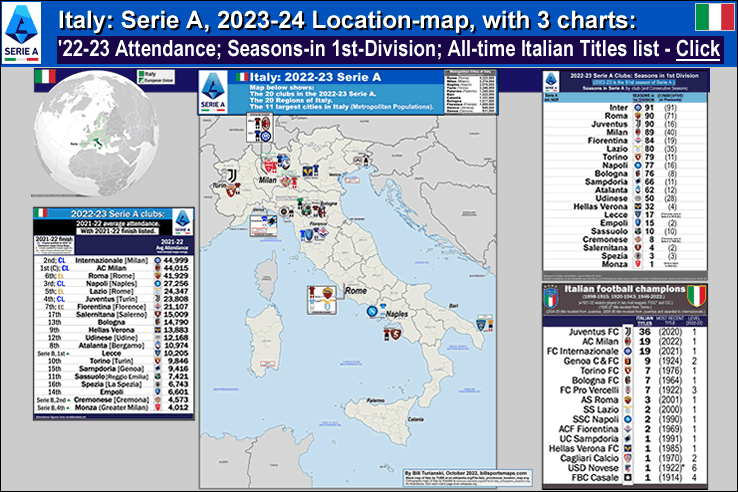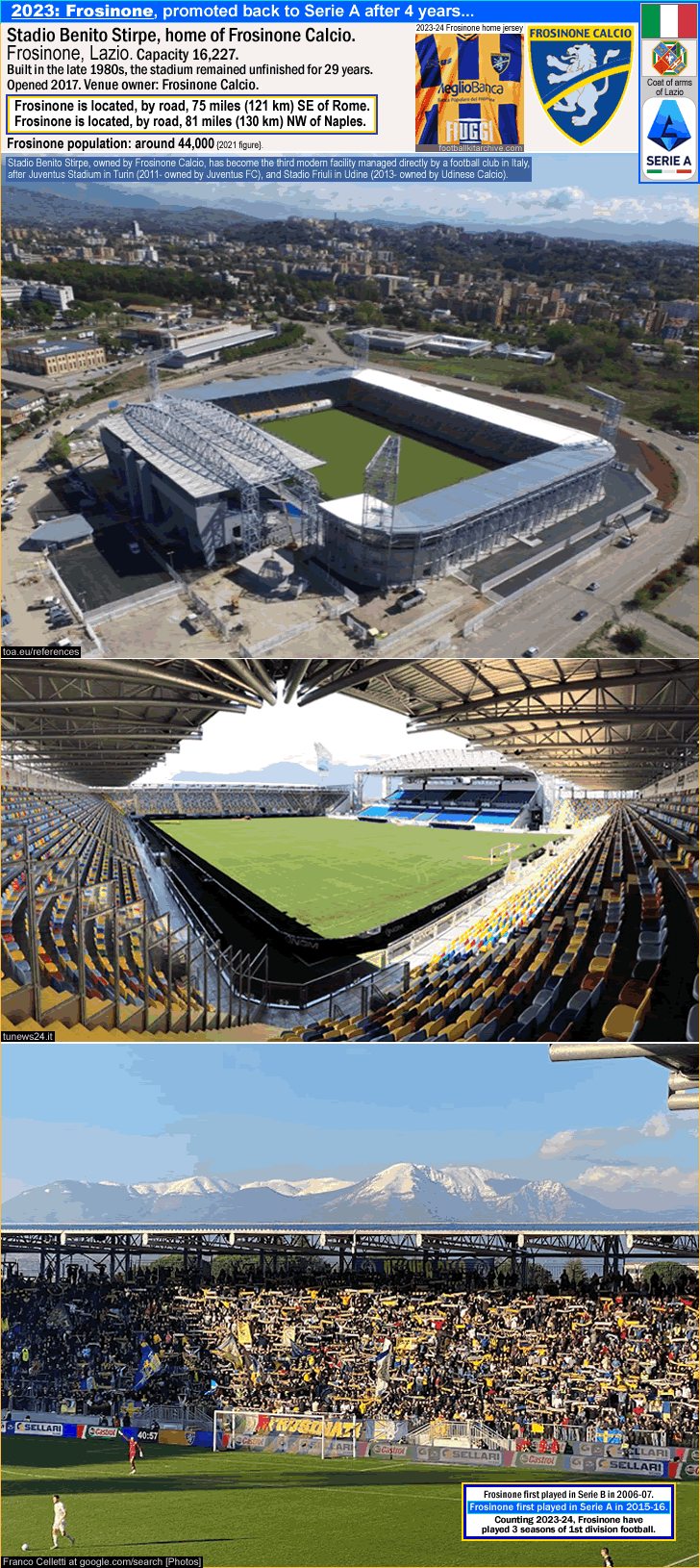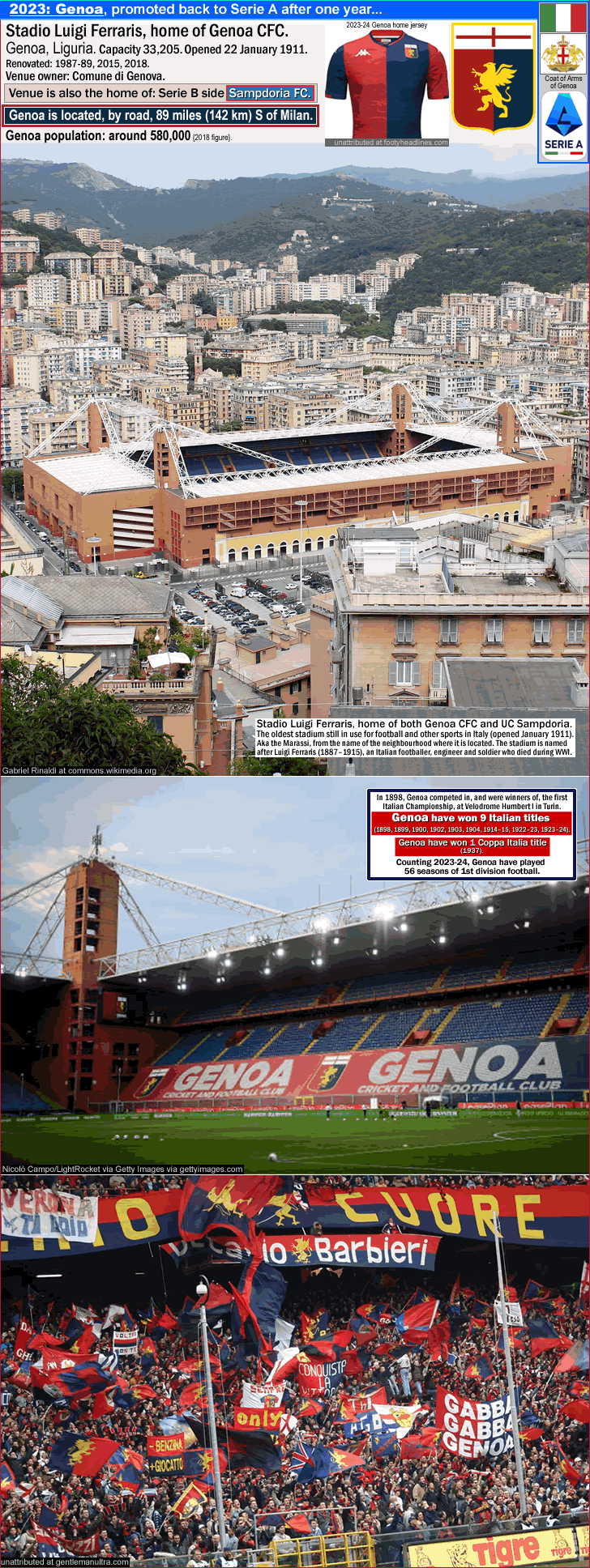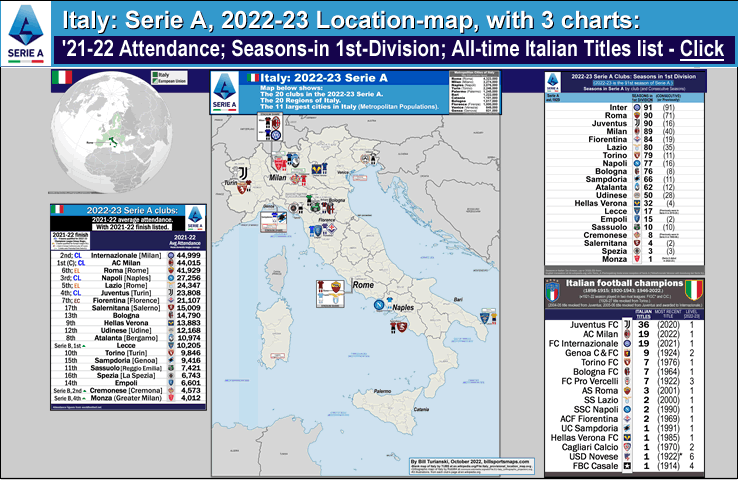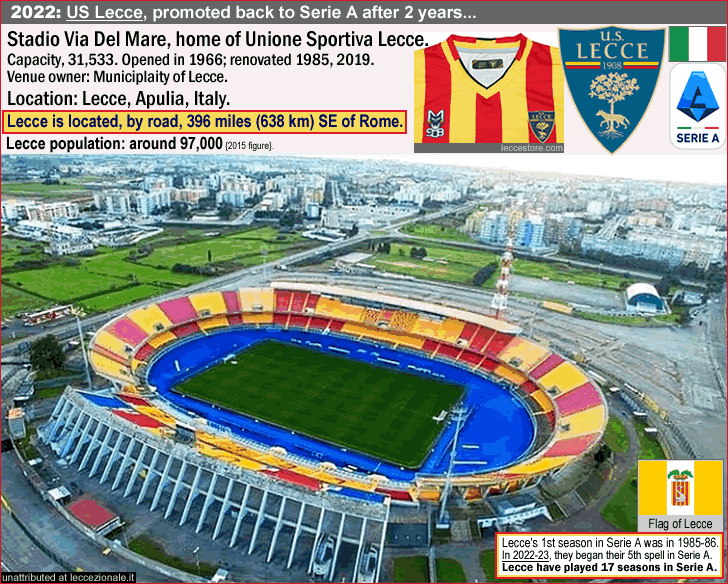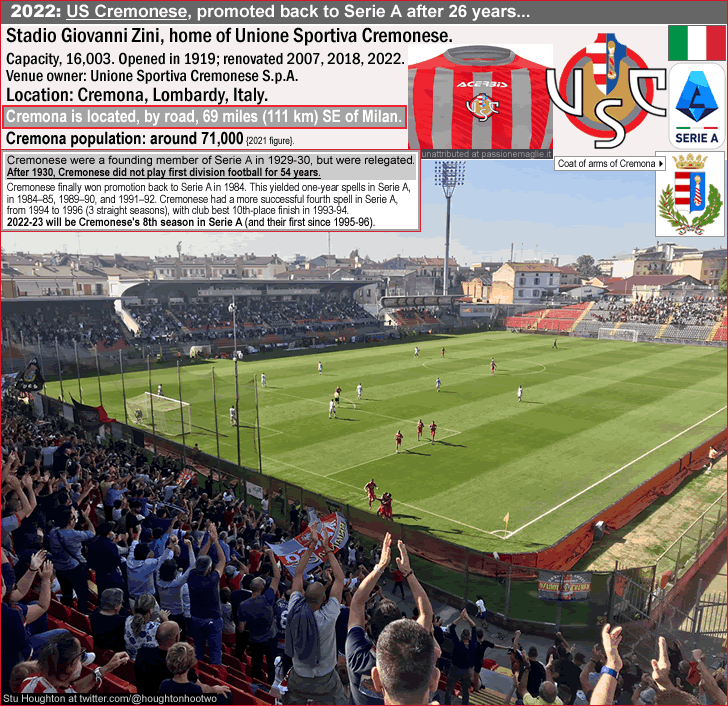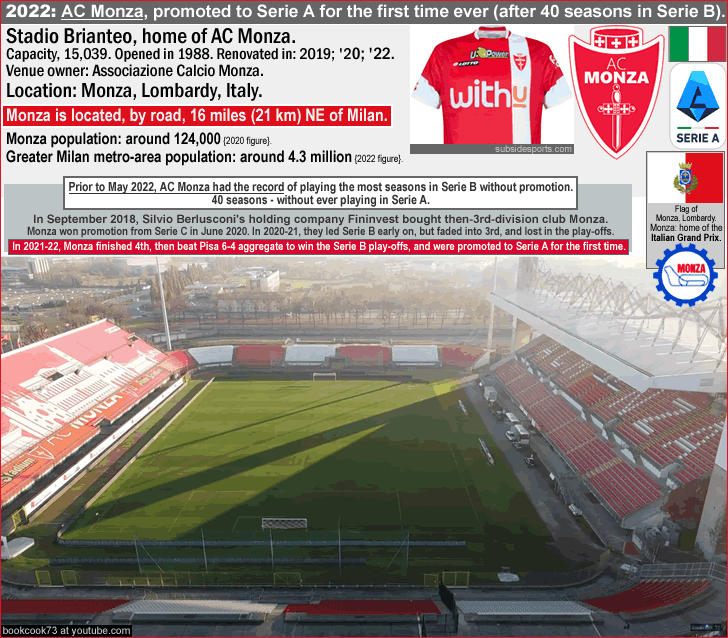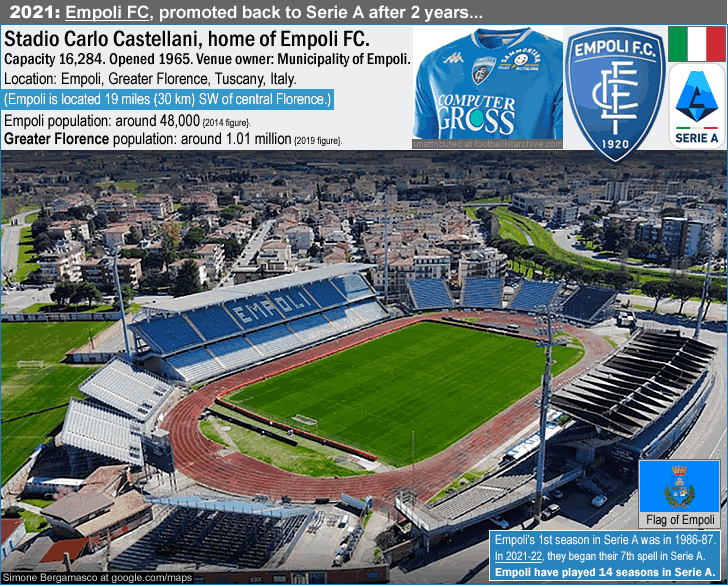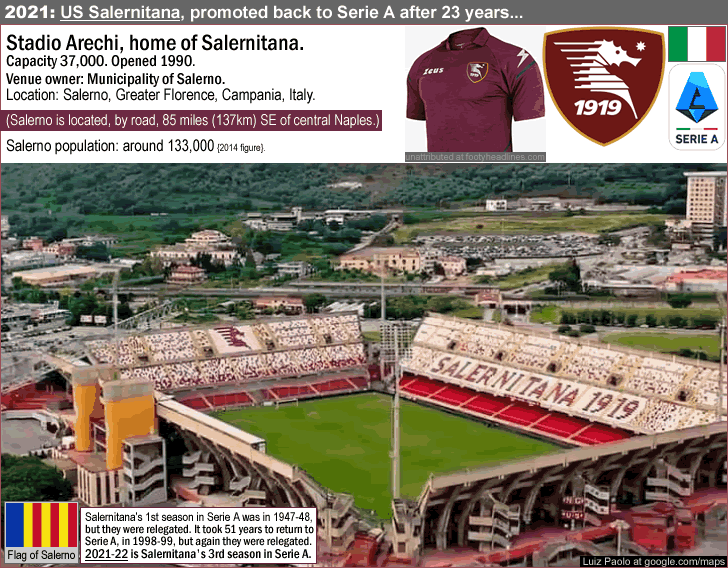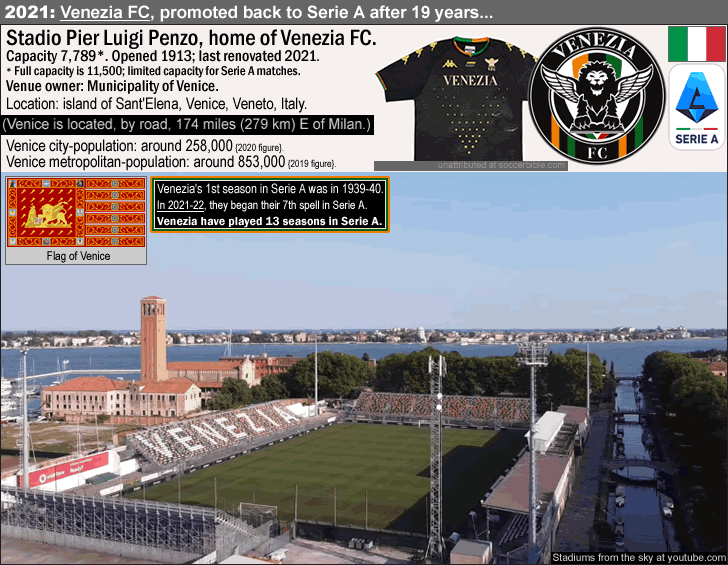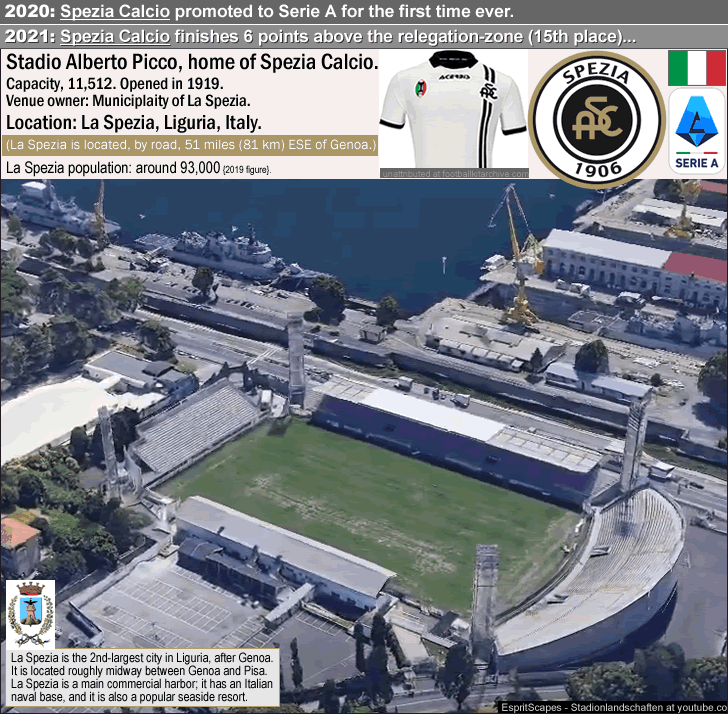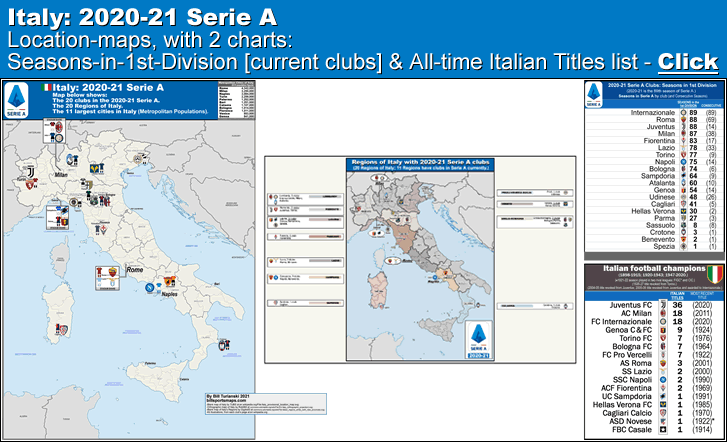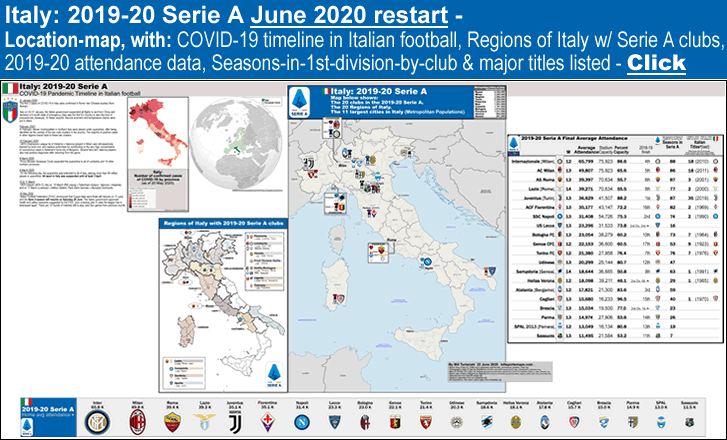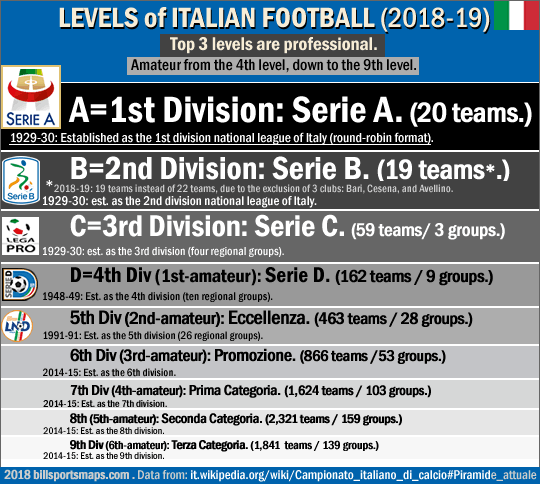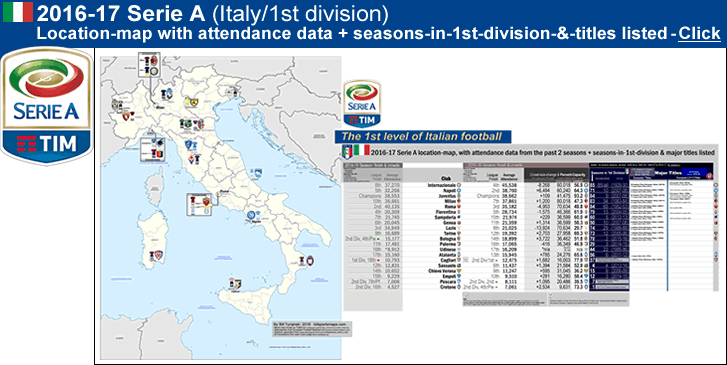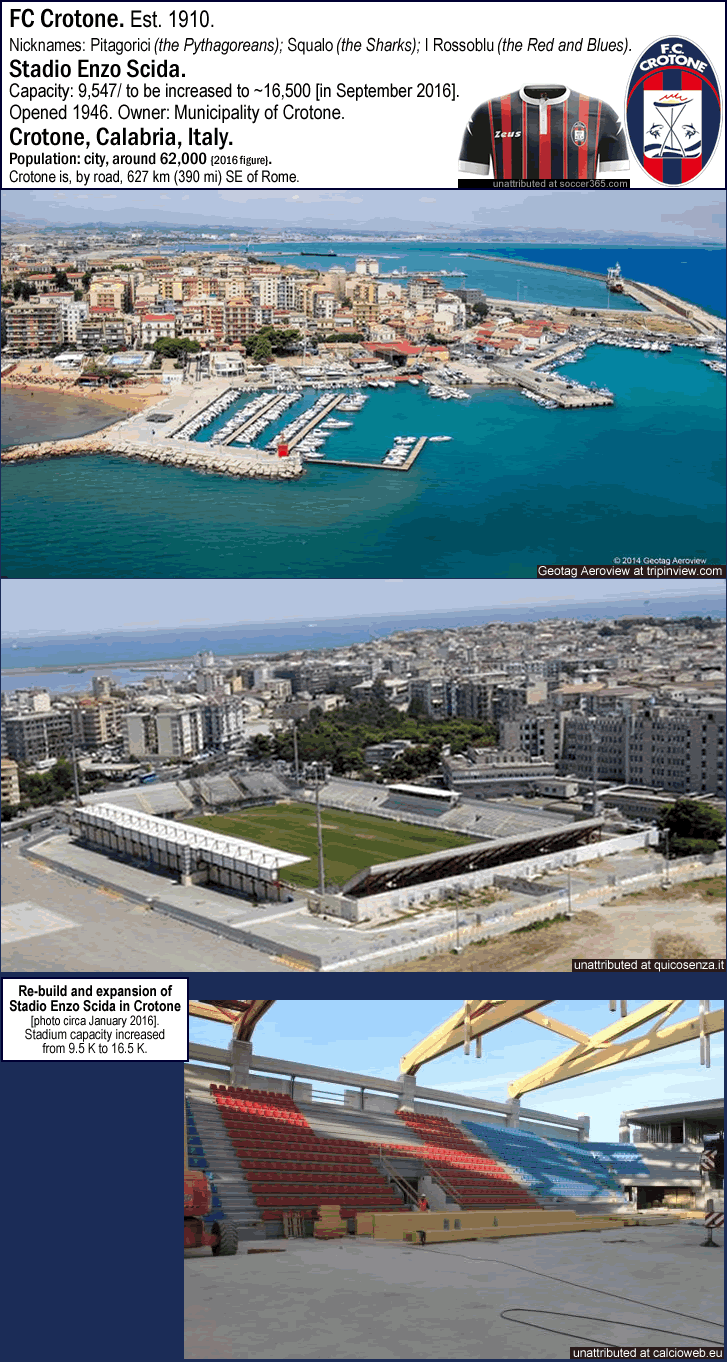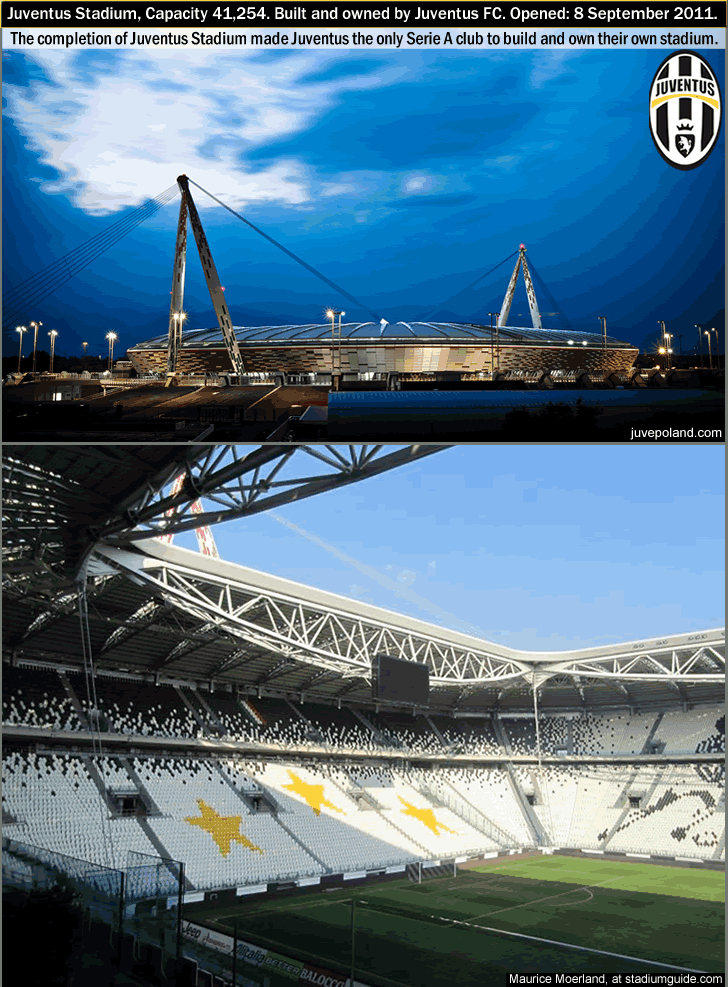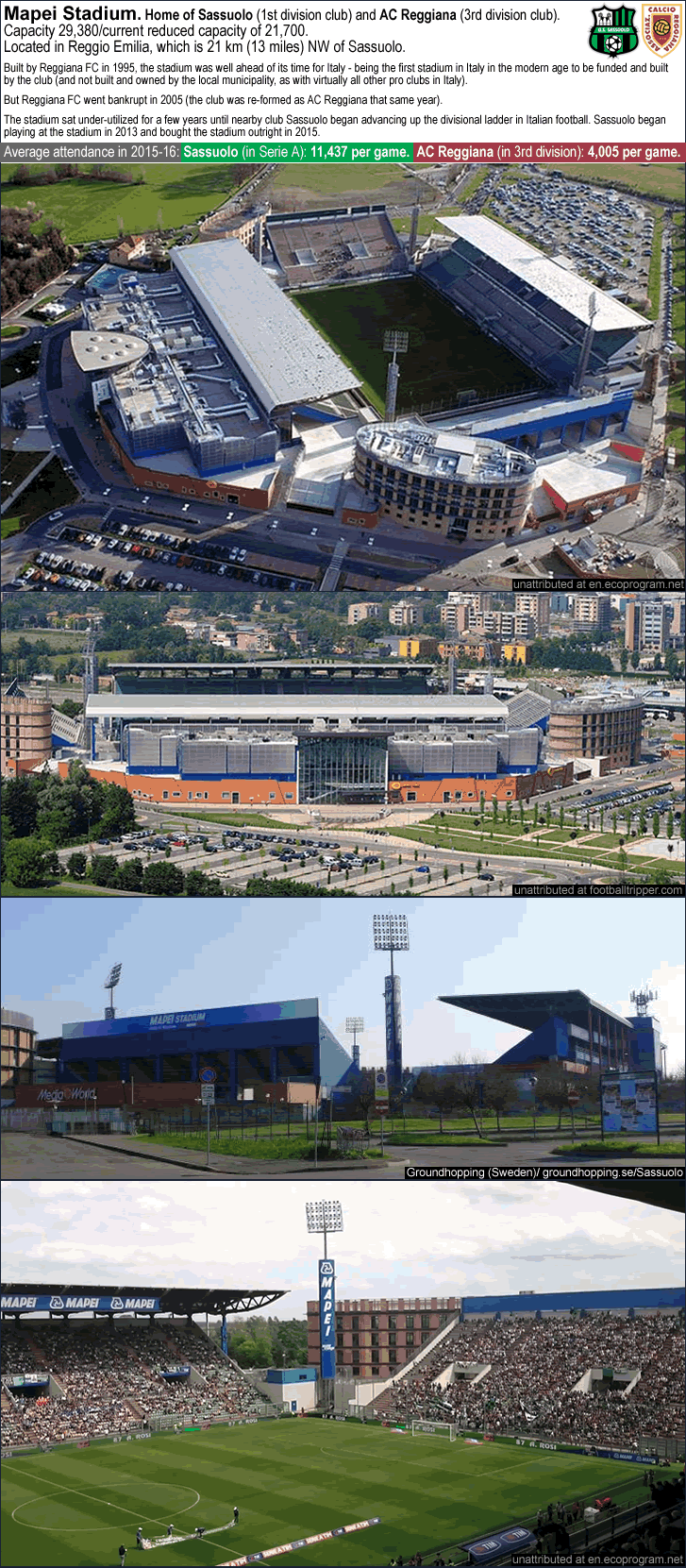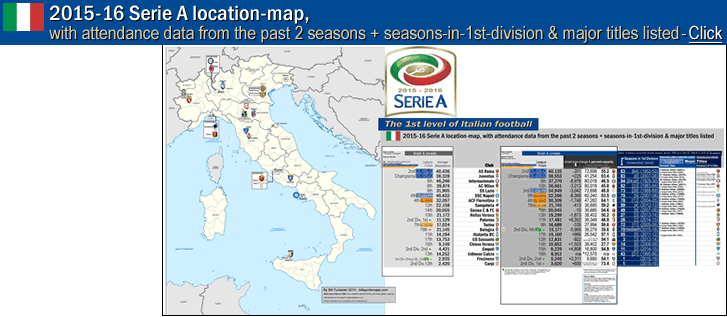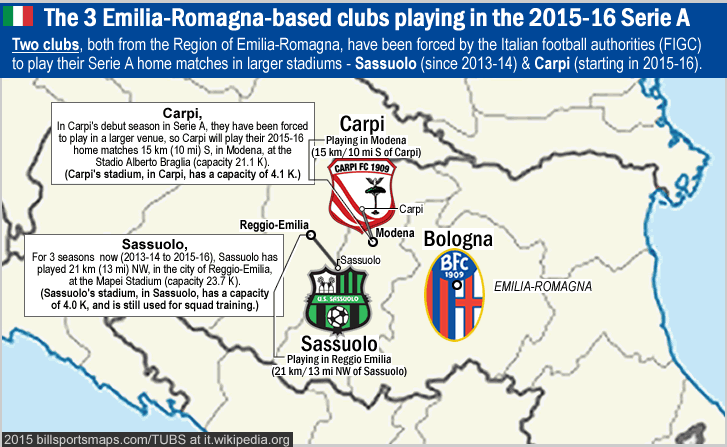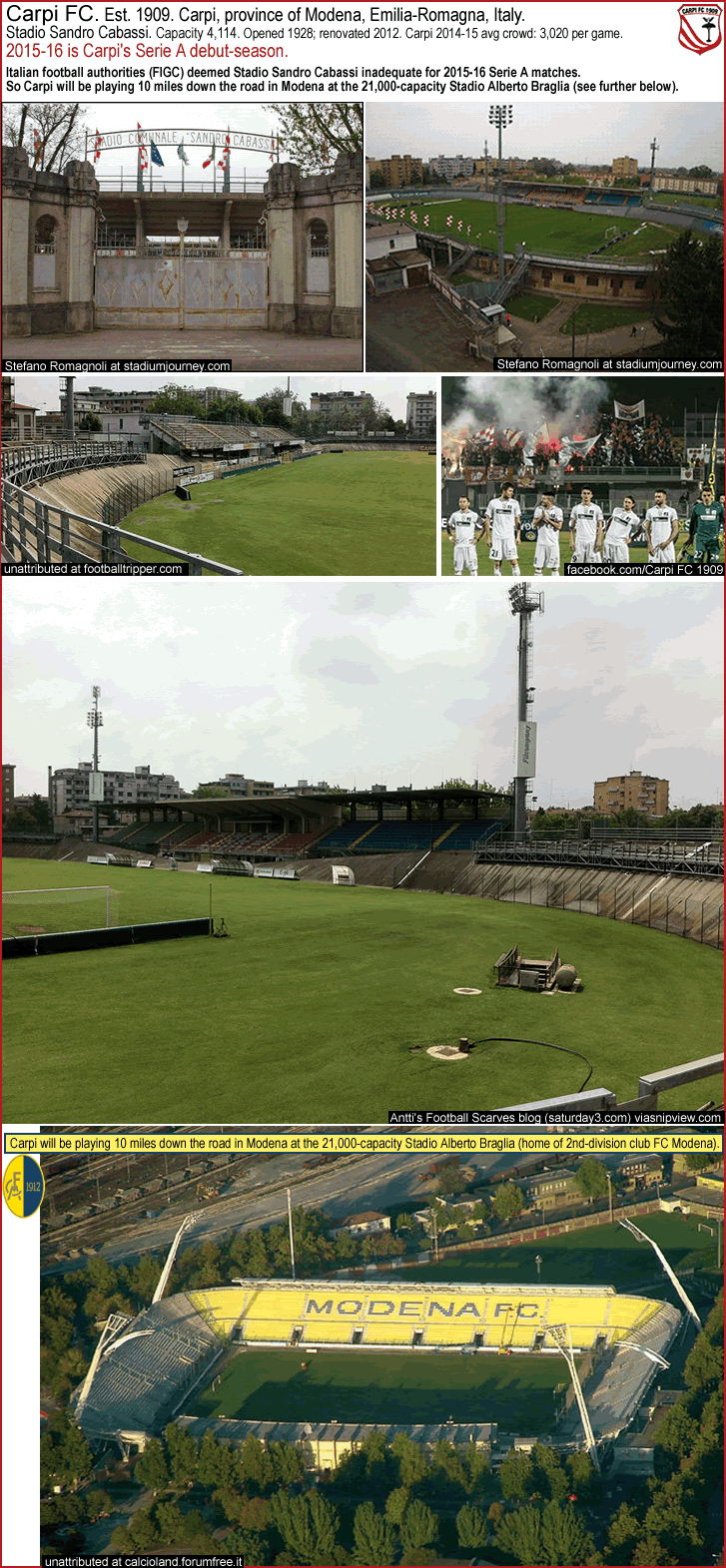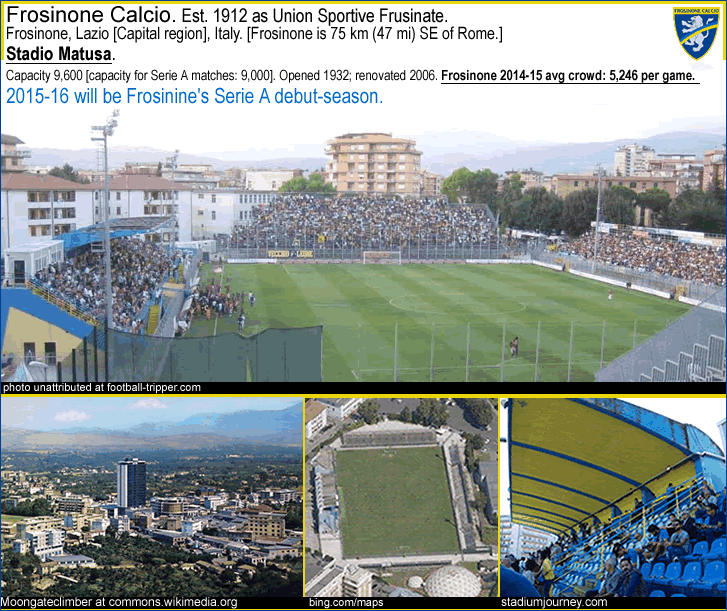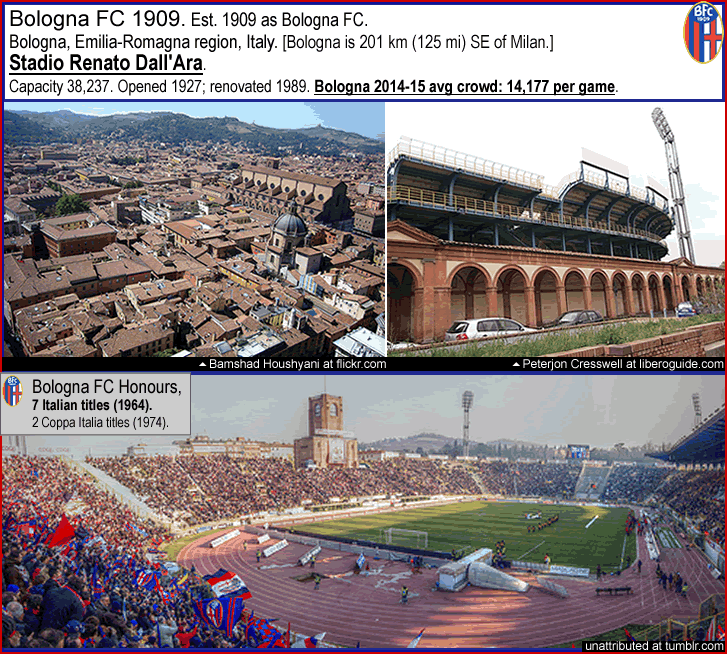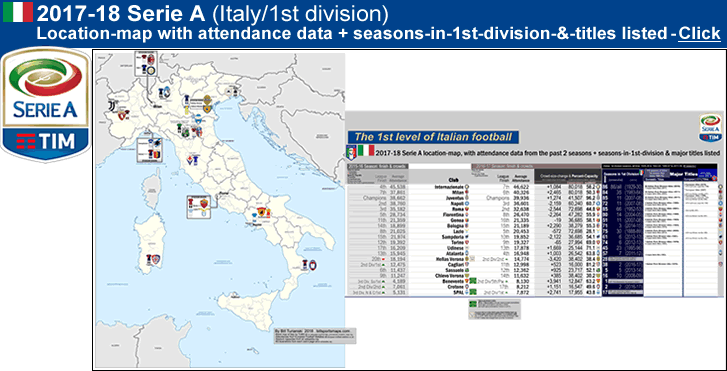
2017-18 Serie A (Italy/1st division) location-map, with: 16/17 attendance data, seasons-in-1st-division-by-club & major titles listed
…
…
By Bill Turianski on 13 January 2018; twitter.com/billsportsmaps.
Links…
-Teams, etc…2017-18 Serie A (en.wikipedia.org).
-Table, fixtures, results, stats, etc…Serie A/summary (soccerway.com).
-English-speaking coverage of Italian football…Forza Italian football.com.
-Here is a nice and concise article…Serie A Stadiums 2017-18 (by Marcello Furgiuele on 14 July 2017 at calcioefinanza.com).
-An interesting take on the failure by the Italy national team to qualify for the 2018 FIFA World Cup, Italy’s World Cup exit is far from an apocalypse (by T.R. at economist.com/[Game theory blog]).
…
A brief summary of the 2017-18 Serie A at the January winter break…
Napoli have a chance of unseating 6-time reigning champions Juventus. After 20 matches, Napoli [at 51 points] have a one point lead over Juventus. Napoli’s only loss came at home versus Juventus, though. Interrnazionale [at 42 pts.] sit 3rd. Lazio [at 40 pts.] sit 4th; Roma [at 39 pts.] sit 5th. Italy will once again will have 4 teams qualify for the UEFA Champions League, and, for the other two CL spots, it looks like it will be a battle between three: Inter, Roma, and Lazio, with the 5th-place-finisher having to settle for a UEFA Europa League spot. The other EL spot is up for grabs between a whole host of teams (Sampdoria, the over-achieving Atalanta, Udinese, Fiorentina, Torino, and the dismally under-performing Milan). The relegation battle includes all the recently-promoted sides from the last two seasons…Crotone, Hellas Verona, and Benevento make up the relegation-zone currently, with SPAL only in safety by virtue of goal-difference, and with Cagliari 5 points above the drop. 6 points above the drop are both Sassuolo and Genoa. Chievo, and also Bologna, could get sucked into the relegation fight. The situation at the bottom of the table gives more credence to the argument that it is time for Serie A to reduce to back to 18 teams.
…
A brief re-cap of the 2016-17 Serie A…
16/17 Serie A champions…Juventus. Juventus are from Turin (Italian: Torino), which is the 6th-largest city in Italy and is located in the Piedmont region, about 46 miles from the Franch border, about 73 miles south of the Swiss border, and 56 miles (98 km) west of Milan. Juventus, which is a Latin word for ‘youth’, is pronounced ‘you-ven-tuss’. Juventus have now won 6 straight Italian titles. Juventus have won the most Italian titles (33, with their first Italian title won in 1905).
Teams that qualified for Europe…
17/18 Champions League Group Stage: Juventus and Roma. 17/18 CL GS play-off round: Napoli. 17/18 Europa League Group Stage: Atalanta, Lazio. EL GS 3rd qualifying round: Milan.
Teams that were relegated out of Serie A, into the 2nd division (Serie B), in May 2017: Empoli, Palermo, Pescara.
Teams that were promoted to the 1st division in May 2017:
SPAL, Hellas Verona, Benevento…
SPAL [Spal is an acronym for Società Polisportiva Ars et Labor]. Ferrara, Emilia-Romagna [northern Italy].
Seasons in Italian top flight: 17 (previously in 1967-68).
Major Titles: none.
Average attendance [as of 13 Jan. 2018]: 11.5 K (at 88%-capacity).
Manager of SPAL, Leonardo Semplici (age 50, born in Florence).
-From ESPN.com, Historic SPAL’s sensational promotion to Serie A (by Michael Yokhin on 13 May 2017 at espn.com/soccer/blog).
-From The Gentleman Ultra blog, Simplicity is the ultimate sophistication’: tracing the miraculous revival of SPAL (by Callum Ric-Coates on 22 August 2017 at thegentlemanultra.com).
SPAL are from Ferrara, which is in the region of Emilia-Romagna [in northern Italy]. The population of Ferrara is around 133,000 {2014 figure}. Ferrara is, by road, 31 miles (50 km) SW of Bologna. SPAL wear sky-blue-and-white vertical stripes (done in retro-style thin striping). The oval-shaped badge of SPAL features the black-white shield that is on the coat of arms of Ferrara.
SPAL were a 1st division mainstay in the 1950s and up to the mid-1960s, but after 1967-68, the club was out of the 1st division for 50 years. In fact, prior to 2016-127, SPAL had not even been in the 2nd division for 24 seasons (not since 1992-93). SPAL reached their low point in the early 21st century, when the club went bankrupt and then were re-formed…twice (in 2005 and in 2012). 2012-13 found the once-again re-formed SPAL stuck in the regional 4th tier; they won promotion on the first try, and for 2013-14, SPAL joined the three-league Italian 3rd tier [aka Serie C, aka Lega Pro].
So, SPAL were in the regional third tier 2 seasons ago, and have won two straight promotions since then, doubling their crowds in the process (from 5.1 K to 11.5 K currently; {17/18 Serie attendances can be seen here}). The architect of this double-promotion-run was manager Leonardo Semplici (age 50). Semplici, who during his playing days played primarily in amateur Tuscan leagues, was hired by SPAL in December of 2014, when he had been running the Fiorentina youth set-up. Budget constraints forced Semplici to find a squad on the cheap, and SPAL fielded a squad entirely made up of Italian-born players, several of whom had been with SPAL when they were a 4th-division side. Semplici’s SPAL play a fast-paced, attacking style, usually in a 3-5-2 formation.
In SPAL’s second season in the 3rd tier, and in Leonardo Semplici’s first full season as manager [2015-16], SPAL won the Lega Pro Group B (North and Central), beating second-place Pisa by 9 points. By this time SPAL were drawing 5.1 K. The following season, SPAL joined the second division (Serie B) for the first time in 24 years. Then SPAL won a second-straight promotion by winning the 16/17 Serie B by 4 points over both Hellas Verona and Frosinone, drawing 7.8 K. SPAL’s main offensive force in Serie B was ex-Leeds-United FW Mirco Antenucci, who scored 18 (see photo and caption below), and Antenucci currently remains SPAL’s top scorer.
But now in Serie A for the first time since 1967-68, SPAL are having a tough time of it, and face a relegation battle. At the winter break, SPAL sit 17th (3 wins, 6 draws, 11 losses), above the relegation zone only by virtue of a better goal difference than Crotone.
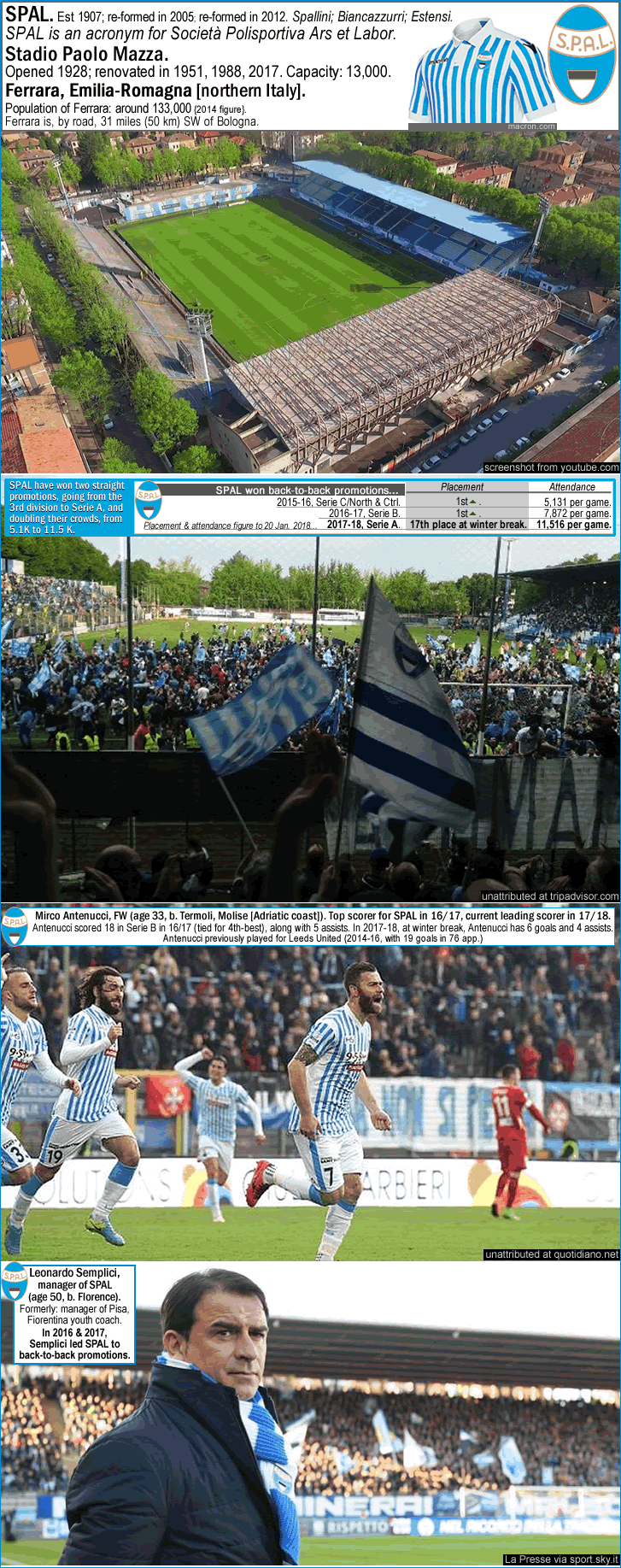
Photo and Image credits above – SPAL 17/18 jersey, photo from macron.com. Aerial shot of Stadio Paolo Mazza, screenshot from youtube.com video uploaded by SPAL 2013 srl at youtube.com. jpg. Tifo at Stadio Paolo Mazza, unattributed at tripadvisor.com. Mirco Antenucci [photo circa March 2017], photo unattributed at quotidiano.net. Leonardo Semplici, photo by La Presse via sport.sky.it.
…
Hellas Verona. Verona, Veneto [northern Italy].
Seasons in Italian top flight: 28 (previously in 2015-16).
Major Titles: 1 Italian title (1985) {see illustration below}.
Average attendance [as of 13 Jan. 2018]: 18.5 K (at 47%-capacity).
Manager of Hellas, Fabio Pecchia (age 44, born in Formia, Lazio).
Hellas Verona are from Verona, in the region of Veneto in northeast Italy. With a city-population of around 215,000, and a metro-area population of around 583,000, Verona is about the 12th-largest city and the 16th-largest metro-area in Italy {List of cities in Italy [by population]; List of metropolitan areas of Italy}. Verona is 105 miles (168 km) E of Milan; and Verona is 75 miles (121 km) W of Venice.
Hellas Verona wear navy-blue with yellow trim. Hellas Verona are nicknamed i Gialloblu (the “yellow-blue”). Their oval crest features yellow-and-navy vertical stripes with 5 devices: the club’s name, the Italian flag, two bull mastiff heads in profile facing opposite directions, with a ladder between them, and a blue shield bearing a yellow cross. (The two dogs’ heads form a V-shape, which you can see in an earlier crest in the illustration below.) The mastiffs are a symbol of the renowned 13th century Veronese magistrate, Mastino I della Scala. Then there is the ladder between the two mastiff’s heads. The ladder was more prominently featured on Hellas Verona badges from the past (again, see the illustration below, which shows an alternate crest from the 1980s which features the ladder device). The ladder is another reference this Veronese ruler from the 1200s named Scala. Because “scala” means ladder in Italian {you can also see this Wikipedia page, and specifically the photo there, which shows a carved stone crest that bears the ladder device, which is very similar to the Hellas Verona alternate crest}. Finally, the blue shield with the yellow cross on the Hellas Verona crest is a reference to the flag of Verona. As to the name “Hellas”: that is a nod to the antiquities…‘ Founded in 1903 by a group of high school students, the club was named Hellas (the Greek word for Greece), at the request of a professor of classics’ {en.wikipedia.org/[Hellas Verona/History]}.
The thing about Hellas Verona is that they are from a medium-sized city (again, Verona, with about 583,000 in its metro-area, is the 16th-largest metro-area in Italy). Yet Hellas Verona still have a local rival that also is big enough to be a top-flight club. I am speaking, of course, about Chievo Verona, who share, with Hellas Verona, the same stadium (the 38.3-K-capacity Stadio Marc’Antonio Bentegodi). There are many cities in Italy that are larger, but do not have two 1st-division-calibre clubs (such as Naples, Florence, Bari, Palermo, Catania, Brescia, and Bologna). To give you an idea of how unusual this is, and how it effectively undermines both clubs’ chances of success, let’s compare this situation to a similar one in England…Sheffield. Sheffield is the 8th-largest metro-area in England (including Wales), and Sheffield has about 100 thousand more people in its metro-area than does Verona (with a population of around 680,000). And like Verona, Sheffield has two clubs that are 1st-division-calibre (Sheffield United and Sheffield Wednesday, both of whom have been in the top flight for 60 seasons or more, and both of whom are currently in the English second division). Yet a couple cities larger than Sheffield, specifically Leeds and Newcastle, only have one 1st-division-calibre club. So, the presence of another big club in a city the size of Shefield is going to undoubtably impinge on things like fanbase size and media coverage. And Verona is about 15% smaller than Sheffield. This is the situation that both Hellas and Chievo find themselves in, basically fighting over a limited pool of potential support. Currently, Hellas Verona are drawing 18.2 K, while Chievo Verona are drawing 11.2 K. That cumulatively is 29.7 K {source}. Thirty years ago [1987-88], when Chievo Verona were a 4th-divison club (attendance of which is unavailble), Hellas Verona were drawing 26.8 K {source}). If you throw in a couple extra thousand or so to represent what Chievo were probably drawing back then, the cumulative attendance for the two Verona clubs 30 years ago would be around ~28-29-K. So, the present-day-Chievo have eaten into the present-day-Hellas Verona’s average attendance to the factor of about 7-to-10-K.
In recent years, when they are in Serie A, Hellas Verona have drawn between 18-and-19-K. Back in their glory days in the mid-1980s, Verona were actually drawing in the high 30-K-range, peaking at a basically-full-capacity 40.1-K in their championship season of 1984-85 (which was, incidentally the season that the all-time peak average attendance (of 38.8 K in Serie A) was reached {source}).
Counting 2017-18, Hellas Verona have spent 28 seasons in the first division. Those 28 seasons in Serie A have been spent in 9 separate spells, starting with their first, one-season-spell in the top flight, in 1958-59. Since the early 1970s, Verona have been relegated from Serie A 7 times (in 1974, 1979, 1990, 1992, 1997, 2002, and 2016). Hellas have also been relegated to the 3rd tier twice (in 1941 and in 2007). {See this league-history chart at Hellas Verona’s Wikipedia page.} In other words, Hellas Verona have gotten relegated a lot. Which makes it even more surprising that the club actually won a Serie A title…
Hellas Verona, the unlikely champions of Italy in 1984-85…
-From Guardian/football, The miracle season when Hellas Verona came from nowhere to win Serie A (by Richard Hough/Gentleman Ultra.com on 11 April 2016 at theguardian.com/football/the-gentleman-ultra).
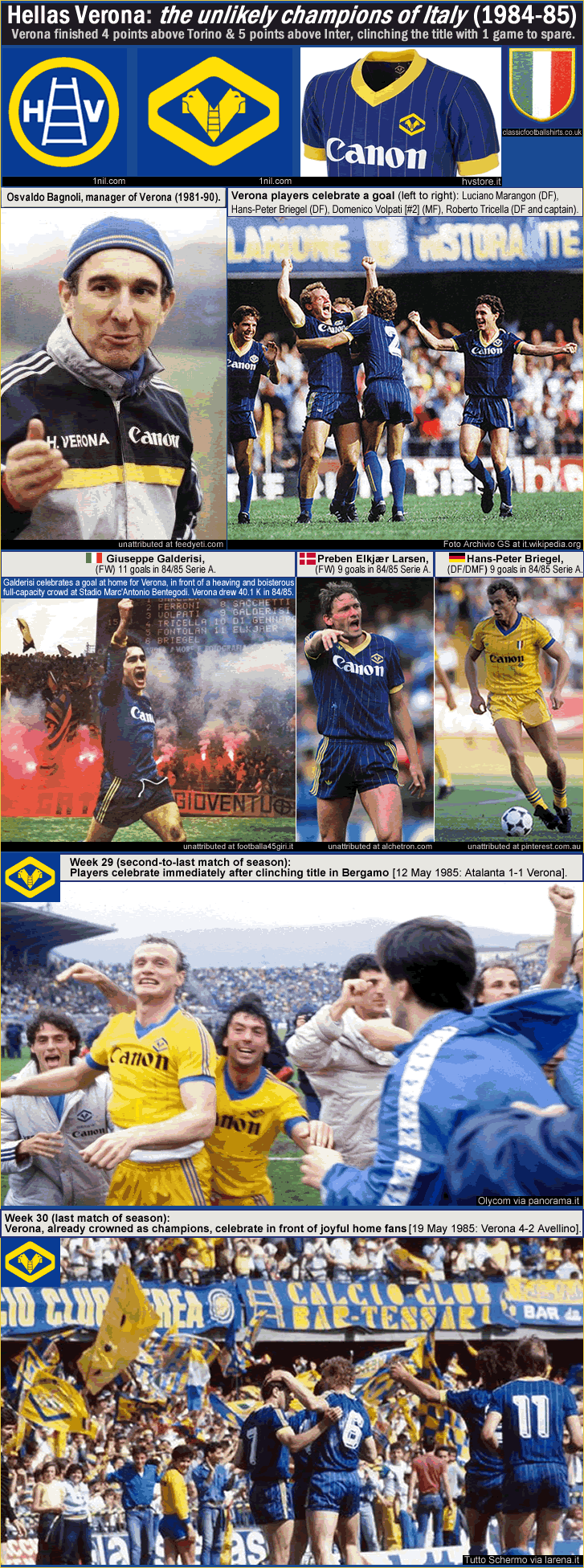
Photo and Image credits above -Verona 1984-85 jersey badge and Verona H-V-ladder alternate badge, images from 1nil.com. Reproduction of Verona 84/85 jersey, photo from hvstore.it. Scudetto shield-patch, photo from classicfootballshirts.co.uk. Verona manager Osvaldo Bagnoli, photo unattributed at feedyeti.com. 4 Verona players celebrating a goal during the 84/85 campaign, photo from Foto Archivio GS at File:Hellas Verona, Serie A 1984-85.jpg. Giuseppe Galderisi celebrates a goal, photo unattributed at footballa45giri.it/calciatore-cantante-nanu-galderisi-45-giri. Preben Elkjær Larsen, photo unattributed at alchetron.com. Hans-Peter Briegel, photo unattributed at pinterest.com. Players celebrate immediately after clinching title in Bergamo [12 May 1985: Atalanta 1-1 Verona], photo by Olycom via panorama.it/sport/calcio/30-anni-scudetto-verona-1985-12-maggio. Verona players celebrate a goal in last home match of season (a week after clinching the title) [19 May 1985: Verona 4-2 Avellino], photo by Tutto Schermo via larena.it.
…
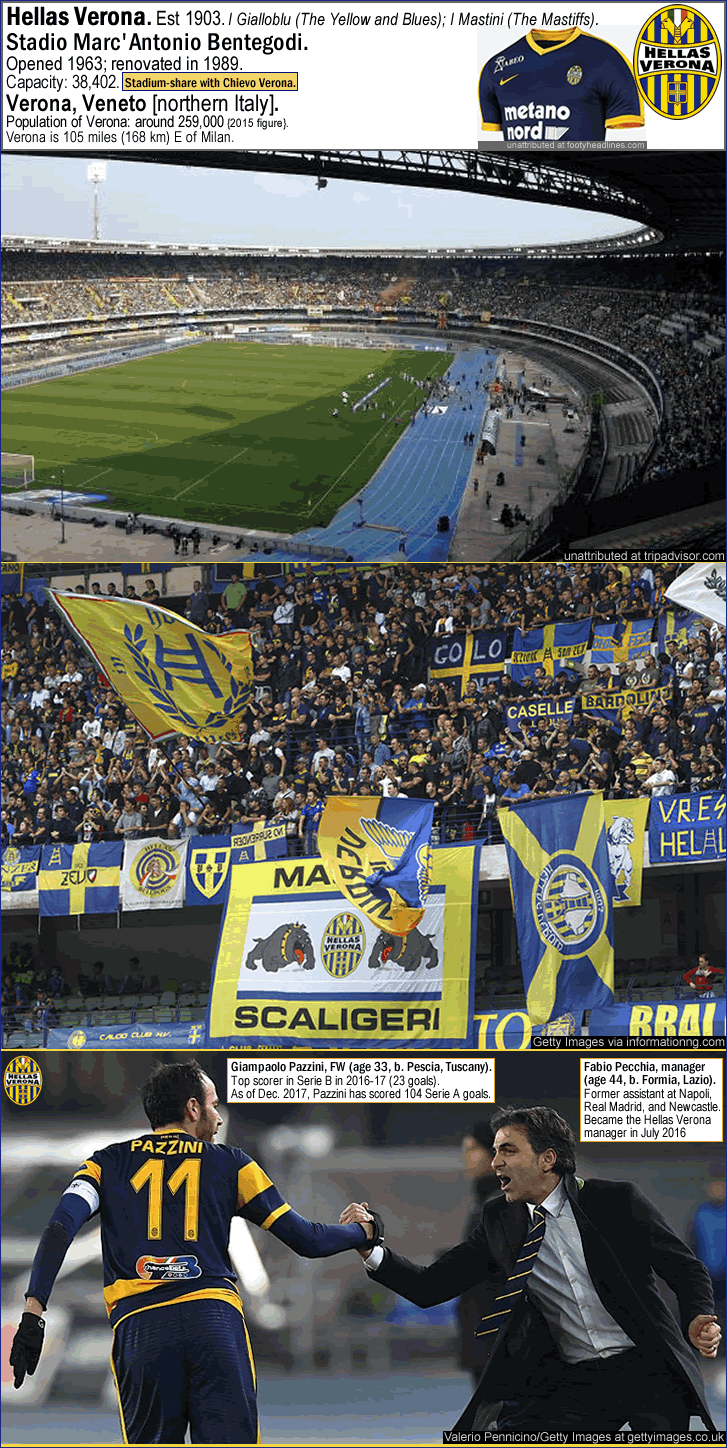
Photo and Image credits above – Hellas Verona 17/18 jersey, photo unattributed at footyheadlines.com. Stadio Marc’Antonio Bentegodi, photo unattributed at tripadvisor.ie Hellas fans’ tifo, photo by Getty Images at Verona Handed Partial Stadium Ban for Racist Chants (informationng.com). Giampaolo Pazzini [photo from Dec. 2016], photo by Valerio Pennicino at gettyimages.co.uk.
…
Benevento. Benevento, Campania [southern Italy].
Seasons in Italian top flight: 1 (2017-18 is Benevento’s Serie A debut).
Major Titles: none.
Average attendance [as of 13 Jan. 2018]: 12.2 K (at 70%-capacity).
Manager of Benevento, Roberto De Zerbi (age 38, born in Brescia).
Benevento Calcio are from the town of Benevento, in the region of Campania. Benevento has a population of only around 60,000 {2015 figure}, and is located, by road, about 60 miles (97 km) NE of Naples.
Benevento wear red-and-yellow vertically-striped jerseys; their badge has red-and-yellow stripes in a shield-shape, with a black silhouetted image of a witch riding a broomstick. The witch on their crest refers to the legend of the witches of Benevento. This folklore dates back to the 8th century, when the quasi-pagan religious rites of the ruling Lombards [a Germanic tribe that originated in Scandinavia], worshipping Odin, by the Sabato River, were interpreted by some of the local Christian population as acts of withcraft. Which is why Benevento’s nickname is Stregoni (the Sorcerers).
Like SPAL, Benevento also have won back-to-back promotions. Unlike SPAL, Benevento had never even been in the 2nd division before 2015! Benevento started their first-ever season in Serie B in 2016-17 with a new manager, Marco Baroni, formerly the manager of Novara. Under Baroni, in their Serie B debut, propelled by the 21 goals of FW Fabio Ceravolo, Benevento qualified for the 2016-17 2nd division promotion play-offs (by finishing in 4th). Then Benevento beat Spezia in the preliminaries, then they beat Perugia in the semifinals, then they beat Carpi in the finals. And so the Sorcerers of Benevento were the unlikely winners of the 2016-17 Serie B promotion play-offs.
But once Benevento got to Serie A, their essentially small-town-/-lower-leagues status caught up with them fast, and they ended up breaking a record in a bad way…Benevento did not win a single point until their 15th match. By this time, Marco Baroni had been sacked, and the new Benevento manager was former Foggia and Palermo manager Robert de Zerbi, who was hired in late October 2017. The squad started playing better, but continued to lose. Benevento finally won their first point on the 3rd of December 2017, in spectacular fashion…against Milan, with a goal in the 95th minute, by their goalkeeper Alberto Brignoli {see screenshots and caption below, also see video: Dramatic goal scored by Benevento goalkeeper Brignoli against Milan (2-2) (0:51 video uploadedby Football Now at youtube.com)}.
After that, going into the 2017 winter holidays, Benevento went back to losing ways and lost 3 in a row. However, then Benevento won two straight right before the January winter break, beating a mediocre Chievo Verona, and then beating a rather decent Sampdoria side. And so, with the considerable amount of weak teams in Serie A this season, Benevento now actually have a shot a staying up…they sit 8 points outside of the safety zone (well, 9 points adrift, if you factor in their minus-30 goal difference). Here is an article from Guardian/football on that, Can Benevento stay up after Massimo Coda’s golden spell against Sampdoria? (by Paolo Bandini at theguardian.com/football/blog).
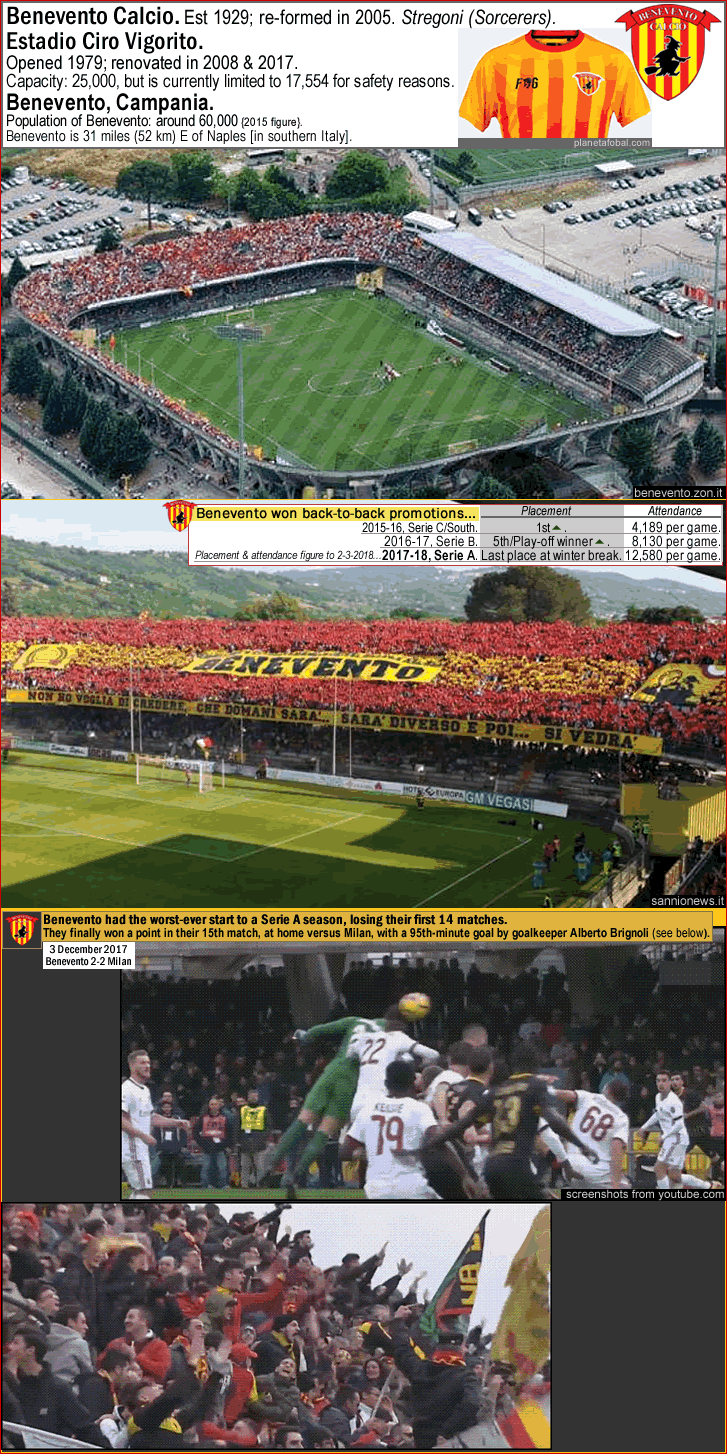
Photo and Image credits above – Benevento 17/18 home jersey, illustration from planetafobal.com/notas/camisetas-de-la-serie-a-de-italia-2017-2018. Aerial shot of Stadio Ciro Vigorito from benevento.zon.it. Tifo, sannionews.it https://www.sannionews.it/wp-content/uploads/2017/02/curva-benevento-calcio.jpg. Screenshots from youtube.com/[Football Now].
___
Thanks to all at the links below…
-Blank map of Italy by TUBS, at File:Italy provincial location map.svg.
-Attendances on map page from E-F-S site, european-football-statistics.co.uk/attn.htm.
-Attendances in text parts of the post: european-football-statistics.co.uk & us.soccerway.com & worldfootball.net.
-Seasons in Italian 1st division: en.wikipedia.org/wiki/Serie_A#Seasons_in_Serie_A; it.wikipedia.org/wiki/Serie_A#Le_squadre.
-Length of current spell in Serie A: de.wikipedia.org/wiki/Serie_A#Teilnehmende_Vereine_in_der_Saison_2017/18.
-General info, crests, kit illustrations, from 2017-18 Serie A (en.wikipedia.org).
